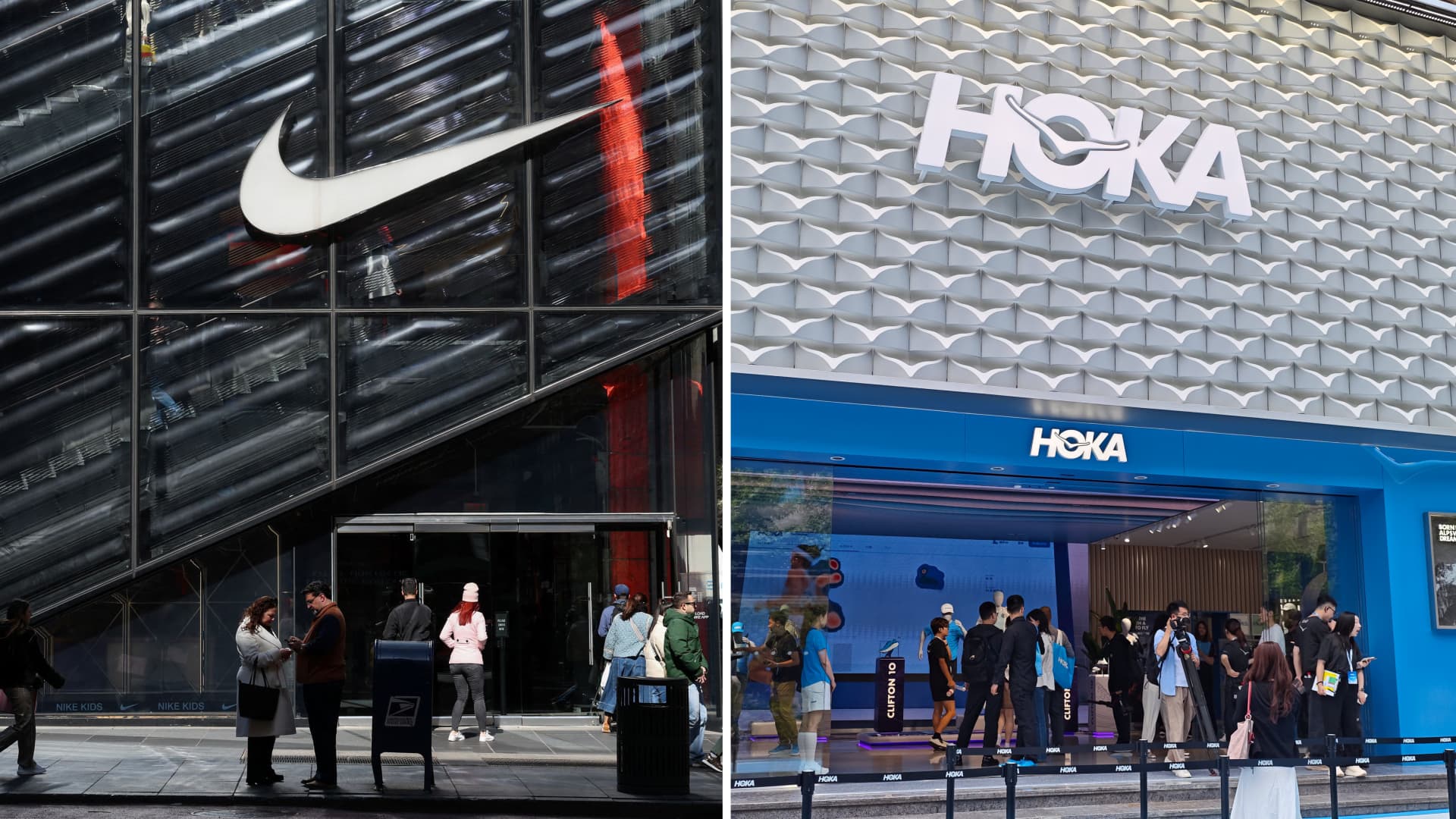Deckers’ rally after its recent quarterly earnings release was short-lived. As of this writing, Deckers is only about 5% above its 52-week lows. This is not a particularly compelling price action unless the stock manages to begin to rebound from these lows – a so-called bearish-to-bullish reversal.
This situation is compounded by the relative weakness we’ve seen in consumer discretionary stocks generally, something we highlighted only a week ago when we wrote about XLY.
Nevertheless, we can sometimes identify trade ideas that look to mitigate sector or industry-specific risks by using a “pairs” trade and taking a bullish position in one company while taking an offsetting bearish position in a company within the same sector or industry.
One such opportunity may be a long position in Deckers Outdoor (DECK) and a short position in its larger and better-known competitor, Nike (NKE), aiming to capitalize on diverging fundamentals within the athletic footwear and apparel sector through the end of 2025. This approach seeks to neutralize broader market risks while exploiting the relative strengths of DECK and the persistent challenges faced by NKE.
The core of this strategy rests on the expectation that Deckers, driven by its booming HOKA brand and robust financial health, will outperform Nike, which continues to grapple with inventory issues, market share erosion, and macroeconomic headwinds. By year-end, we anticipate a convergence in valuations, benefiting from DECK’s upside and NKE’s potential weakness.
Deckers’ appeal stems from its significant brand momentum and sound financial footing. The Hoka brand has achieved remarkable growth. Expansion in the Asia-Pacific region (especially China) mitigates U.S.-centric risks.
Despite a nearly 50% year-to-date stock decline due to broader retail slowdowns and tariff concerns, Deckers’ underlying fundamentals look pretty good. A strong balance sheet allows for aggressive share repurchases and operational flexibility. Valuation metrics are attractive, well below competitor Nike and the broad market; a trailing P/E of 17.2 and a forward P/E of 17.6.
Year-end seasonal demand for UGGs may also prove to be a tailwind. Even with high inventory and tariff impacts, Deckers’ enterprise value-to-sales ratio of just over 2.5 is very close to that of Nike despite considerably better growth, another metric illustrating the relative undervaluation. Should consumer spending stabilize, DECK could rally 20-30% by December 2025.
Nike, meanwhile, continues to face significant structural challenges and a decelerating trajectory. The company reported a 12% revenue decline in Q4 2025, reaching $11.1 billion, due to persistent inventory gluts and weakening demand in key markets like North America and China. Earnings per share growth has plummeted, with further erosion projected due to elevated costs and discounting pressures.
Nike’s stock has entered a deep bear market, down nearly 60% from its 2021 highs, reflecting lost market share to agile competitors such as Hoka, On Running and Lululemon. Stagnant innovation in core lines like Air Jordan and a flawed direct-to-consumer strategy under former CEO John Donahoe have alienated retail partners and diminished brand desirability among younger demographics.
Although the trade war does appear to be cooling off, tariff shocks continue to be a significant risk, as Friday’s market swoon illustrated. Nike is estimating over $1 billion in additional costs from duties on imports, straining EBITDA margins further (currently around 14%). While recent earnings slightly exceeded lowered expectations, prompting some tactical analyst upgrades, these do not necessarily indicate a sustainable turnaround.
The current valuations suggest that some investors believe the company will either return to prior growth rates or the wider-than-average net income margins the company enjoyed in 2021.
Rationale for the pairs trade
Pairing DECK and NKE allows the trade to isolate company-specific divergences while neutralizing broader industry factors like economic slowdowns or tariff escalations.
Deckers exhibits superior growth rates and a lower P/E multiple than Nike, without the latter’s turnaround uncertainties. While DECK’s volatility (14.84%) exceeds NKE’s (9.37%), this favors the long side in a rebound scenario. This trade hedges against broader retail weakness, as both companies operate in athletic footwear, yet Hoka’s momentum directly encroaches on Nike’s performance segment. As a thought exercise, even if Decker’s net income margins were cut in half, thus declining to those of Nike’s anticipated margins in the 2026/2027 time frame of 7.5%, Deckers would be trading at roughly the same multiple as Nike with better topline growth.
Risks include a potential Nike rebound from aggressive restructuring or unexpected demand surges, or Deckers succumbing to tariff pressures despite its strong balance sheet. However, with DECK’s enterprise metrics undervalued and NKE’s drawdown signaling capitulation, the spread between the two could widen favorably.
Pairs trades take time to play out, and it’s always possible that the significant valuation discrepancy is a result of something that some investors have identified that we fail to see. Consequently, higher probability, positive carry options trades make sense. In this case, I would recommend selling upside call spreads in Nike and downside cash covered puts or put credit spreads in Deckers. See the example trades below.
DISCLOSURES: None.
All opinions expressed by the CNBC Pro contributors are solely their opinions and do not reflect the opinions of CNBC, NBC UNIVERSAL, their parent company or affiliates, and may have been previously disseminated by them on television, radio, internet or another medium.
THE ABOVE CONTENT IS SUBJECT TO OUR TERMS AND CONDITIONS AND PRIVACY POLICY. THIS CONTENT IS PROVIDED FOR INFORMATIONAL PURPOSES ONLY AND DOES NOT CONSITUTE FINANCIAL, INVESTMENT, TAX OR LEGAL ADVICE OR A RECOMMENDATION TO BUY ANY SECURITY OR OTHER FINANCIAL ASSET. THE CONTENT IS GENERAL IN NATURE AND DOES NOT REFLECT ANY INDIVIDUAL’S UNIQUE PERSONAL CIRCUMSTANCES. THE ABOVE CONTENT MIGHT NOT BE SUITABLE FOR YOUR PARTICULAR CIRCUMSTANCES. BEFORE MAKING ANY FINANCIAL DECISIONS, YOU SHOULD STRONGLY CONSIDER SEEKING ADVICE FROM YOUR OWN FINANCIAL OR INVESTMENT ADVISOR.
Click here for the full disclaimer.
This post was originally published on CNBC Markets




